Reviews
Louis Malle
France, 1960
Credits
Review by Leo Goldsmith
Posted on 18 November 2010
Source New Yorker VHS
Categories Malle Entendu: The Ecstatic, Eclectic Cinema of Louis Malle
By rights, Raymond Queneau’s Zazie dans le métro ought to rank quite highly among the great unfilmable novels of the 20th century. Rife with a peculiar francophonic mix of slang, wordplay, and toilet humor, and compressed into an all-in-a-day temporality, the sometime surrealist and Oulipo-founder’s hugely popular 1959 children’s book owes more than a little to James Joyce’s Ulysses and, though a fraction of the length, may be just as dense. All the more impressive, then - if not foolhardy - that Louis Malle chose to adapt the novel just a year after its publication. Riding high on the success of 1958’s The Lovers - only his second feature, an international sensation, and the film that prompted Justice Potter Stewart to declare that he knew pornography when he saw it - Malle must have felt emboldened to try something completely different. This would not be the last time - he famously made a career of tonal and stylistic 180s - but Zazie dans le métro seems a weird film even for Malle, a giddy foray into farce where nothing remains still (or intact) for long. But perhaps fittingly, it’s also a film that captures the director’s sense of the mercurial nature of identity with a kind of gleeful, manic relish.
1960 was, of course, a year for bold statements in French cinema. Godard’s Breathless hit Paris theaters in March, hot on the heels of Truffaut’s 400 Blows the previous year. Malle’s films often dovetail quite neatly with those of the Nouvelle vague, even anticipating their work in some ways, but he was never quite a card-carrying New-Waver. In many ways, he was much more of a self-conscious craftsman, even taking pains to highlight his IDHEC training against his contemporaries’ more off-the-cuff amateurism. Thus the joke that comes early in his Zazie: a gaggle of characters hops into an old clunker that won’t start, and one character quips, “What do you want? It’s the Nouvelle vague!” Just like the métro, which is hobbled by a perpetual strike for the duration of the film, everything about the hip, new cinematic Paris is shabby, chaotic, and dysfunctional.
At the same time, Zazie’s Paris is still very much the same urban playground as that of Godard and Truffaut, a vivid wonderland of possibility and romance for its inhabitants. But for Zazie, the strong-willed, free-spirited, slightly malevolent, and alternately charming and irritating little gamine of the film’s title, it’s also an invitation to derision, mischief, and hilarity, an adult world that’s easily mocked, subverted, and manipulated for the purpose of acquiring more important things, like ice-cream and blue jeans. (The realization of her grandest wish, a ride on the métro, is hampered that pesky labor strike.) Zipping into Paris from the provinces with her promiscuous mother, who’s in town for a 24-hour lovers’ tryst and hastily foists the brat on her odd, enormous Uncle Gabriel, the unremittingly precocious Zazie takes the opportunity to wreak havoc on Paris’s community of heterogeneous weirdoes by shoplifting, casting insults, and making lewd comments and accusations. (Both Queneau’s “children’s” novel and Malle’s “children’s” film are remarkably inappropriate for children.) When a kindly lady, late in the film, gently advises Zazie that she should not brutalize big people, Zazie responds with her favorite catchphrase: “My ass!”
Declaring that her aspiration is to be a teacher just so she can “piss off the little brats,” Zazie functions as a parodic opposite to the sensitive and introspective young Antoine Doinel (to say nothing of the tender, airborne lad of Lamorisse’s The Red Balloon). But even so, she also asserts a theme dear to Truffaut: the resilience of children in the face of cruelty, even perversity, of the adult world. If anything, it’s the grown-ups who are the crazy ones, awkward messes of contrary passions and pretensions. None so embodies these contradictions as Uncle Gabriel (a wonderful early performance by Philippe Noiret), the eloquent, pompous, dimwitted, and perfumed dandy, who spends his nights as a Spanish ballerina. (“An elephant in a tutu,” Zazie later describes him, once she finally learns the truth about his occupation.) Though Zazie often accuses him of being a “hormosessuel,” despite not knowing what the word means, he attracts all manner of affection from lady-admirers and is married to the stunning Albertine, who is herself a paradox, being somehow icy and doting all at once. (She will enact her own sort of transgender performance by the film’s end.) And then there’s Trouscallion, a.k.a. Pedro Surplus, a.k.a. Aroun Arachide: policeman, con man, or pervert (what’s the difference?), who shadows Zazie around Paris with indefinite - but definitely creepy - intensions. Against all this polymorphous perversity, Zazie’s embarrassing, foul-mouthed frankness seems wholly warranted.
To match Zazie’s adorable abuse of her elders, Malle imports a great deal of Queneau’s verbal acrobatics (subtitlists, beware!), while deploying seemingly every cinematic sleight of hand he can think of (or afford). He shows a particular flair for silent-comedy camera-tricks and devices: jump-cuts and fast-motion, endless slapstick and chase sequences, continuity craziness and sub-Mélièsian mischief. Characters change wardrobes, genders, even races within a single sequence, scenery shifts under the actors’ feet or collapses on their heads, and any kind of violence - from slaps to muggings to gunshots to the head - might occur at any moment. An utterly queasy sequence atop the Eiffel Tower and a logic-free car chase in a traffic jam suggest a Parisian cityscape in which the four fundamental interactions of physics simply do not apply. Even the billboards that form the city’s backdrop - massive nonsensical Cubist assemblages of colors and letters designed by photographer, filmmaker, and former Fernand Léger student William Klein - give the sense of a world completely unmoored from reason. (And this several years ahead of Godard’s masterful détournements of advertising and the printed word in A Married Woman and 2 or 3 Things I Know About Her.)
All of this concludes the only way it can: with a riot, and an extraordinarily drunken and violent one at that. In this mélee - which Queneau described as a “magma humain” - wait-staff, tourists, neighborhood cranks, and a torch-juggling polar bear demolish a restaurant before being descended upon by a sinister gang of police and brown-shirts. For a film that seems so deceptively apolitical and jolly, it’s a shocking, dark, and brutal ending, played with the cavalier attitude of a Frank Tashlin finale or a live-action approximation of The Itchy & Scratchy Show.
But Zazie, forever nonplussed by the lunacy of the adult-world and tuckered out from a long day of crafty subversion, sleeps through the whole thing. After fomenting a revolution, she misses the war, now seemingly exhausted by the intolerably juvenile behavior of her elders. And even after the strike ends, she still misses her chance to ride the métro.
More Malle Entendu: The Ecstatic, Eclectic Cinema of Louis Malle
-
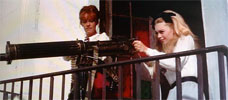
Viva Maria!
1965 -
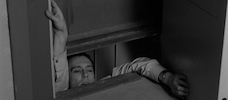
Elevator to the Gallows
1957 -
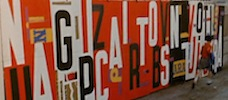
Zazie dans le métro
1960 -
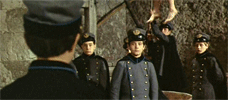
William Wilson
1968 -
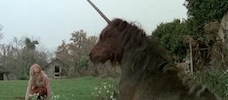
Black Moon
1975 -
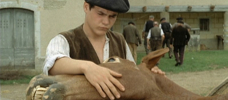
Lacombe, Lucien
1974 -

Atlantic City
1980 -
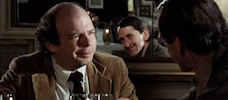
My Dinner with Andre
1981 -
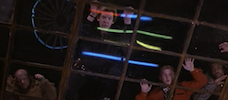
Crackers
1984 -
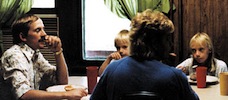
God’s Country
1985 -

Vanya on 42nd Street
1994
We don’t do comments anymore, but you may contact us here or find us on Twitter or Facebook.



